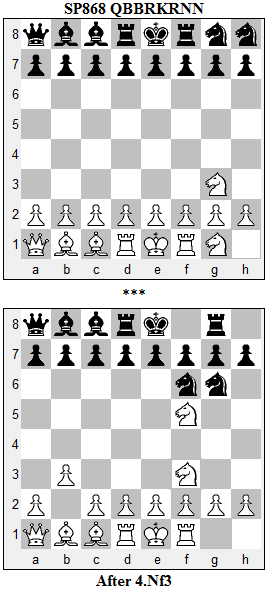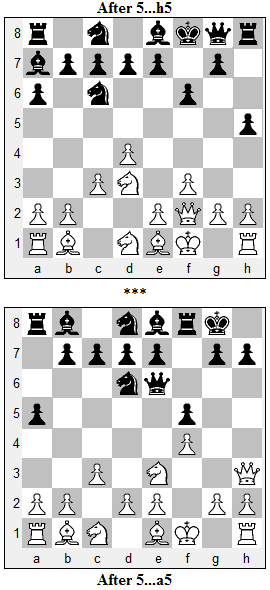The position after White's first move is shown in the top diagram. White threatens 2.Nf5, attacking g7 with the not-so-trivial threat of a smothered mate. I was playing Black and quickly determined that I didn't have many options. I finally decided to give up the possibility of castling O-O, and played 1...Nf6 2.Nf5 Rg8. The game continued 3.b3 Ng6 4.Nf3, reaching the position shown in the second diagram.

Now I played 4...Nf4, with an attack on e2 which seemed to prevent White from castling O-O. White played 5.O-O! anyway, after which I realized that the e-Pawn is poison because of Black's subsequent weakness on the e-file. The game continued 5...d6 6.Ng3 b5 7.c4 bxc4, when I discovered that White almost has a forced win. I requested to take the game back to White's fourth move and, in the spirit of discovering the truth about the initial SP, HarryO agreed.
My second attempt from the diagrammed position (instead of 4...Nf4) was 4...c5. The game continued 5.d4 b6 6.c4 Nf4, with the same idea as the first variation, but in a different setting. This time the move 7.O-O was not as powerful. After 7...Nxe2+ 8.Kh1 d5, White tried 9.Ba3. This led to a series of exchanges which took the pressure off Black. After move 15, we agreed that Black was out of danger and decided to start a new game with the corner Queen and Bishop swapped. That next game is being played at Non-Random Chess960 Trial Game 9: SP864.
Around the same time that the SP868 game started, I was working on a series of posts for my main blog with the theme of 'engine evaluation'. On one of those posts -- One Imbalance Leads to Another -- I learned that the value of castling is approximately equal to a Pawn. This meant that when I gave up castling O-O by playing 1...Nf6, I was making the equivalent of a Pawn sacrifice. I looked again at the position after 1.Ng3, and discovered that the alternative 1...g6 can also lead to a Pawn sacrifice, where Black has considerable compensation for the Pawn. If this is true, then Black has two methods of meeting the difficult challenge posed by 1.Ng3.

